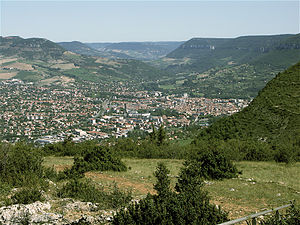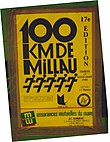Millau
|
Millau Milhau |
||
|---|---|---|

|
|
|
| region | Occitania | |
| Department | Aveyron | |
| Arrondissement | Millau ( sub-prefecture ) | |
| Canton |
Millau-1 Millau-2 |
|
| Community association | Millau Grands Causses | |
| Coordinates | 44 ° 6 ′ N , 3 ° 5 ′ E | |
| height | 340-888 m | |
| surface | 168.23 km 2 | |
| Residents | 22,109 (January 1, 2017) | |
| Population density | 131 inhabitants / km 2 | |
| Post Code | 12100 | |
| INSEE code | 12145 | |
| Website | Millau | |
 View of Millau |
||
Millau ( Occitan Milhau ) is a southern French municipality with 22,109 inhabitants (as of January 1, 2017) in the Aveyron department in the Occitania region . It is a sub-prefecture of the arrondissement of the same name and was the capital of the south of the historic province of Rouergue .
location
The city of Millau is 350 m above sea level. d. M. in the Grands Causses Regional Nature Park at the confluence of the Dourbie and the Tarn ; The Tarn gorges begin about 10 km to the northeast . Rodez , the historic capital of the Rouergue, is about 66 km (driving distance) to the northwest.
history
Several statue menhirs in the area suggest that the area was populated by hunters and shepherds as early as the Neolithic ; later Celtic tribes settled here. The Tabula Peutingeriana shows that the place was called Condatomagus in Roman times ; there was an important pottery center for terra sigillata goods in La Graufesenque . During the migration period , the geographical center of the place now called Amiliavum shifted to the west bank of the Tarn. Sheep and goat breeding was mainly carried out in the area; The leather of the young animals was processed into gloves in Millau as early as the 9th and 10th centuries . Probably already in the 11th century the place received a city wall ( remparts ) and the vice-county of Millau came into being . During the Hundred Years War (1337-1453) the city was in the hands of the English for a long time; in 1476, Louis XI. to the French crown . From the 15th to the 18th century, Millau and the entire Rouergue experienced an economic and cultural heyday.
Population development
| year | 1800 | 1851 | 1901 | 1954 | 1999 | 2013 |
| Residents | 6,077 | 10,041 | 18,701 | 19.209 | 21,339 | 22.205 |
The population increase in the 20th century is mainly due to the immigration of people from the rural areas in the area.
politics
Town twinning
Millau maintains city partnerships with the following cities :
|
Economy and Infrastructure
Business
Leather gloves have been handcrafted in Millau since the Middle Ages ; the city is then also known as the “glove capital”. The heyday of the manufactories and the later leather industry began in the Renaissance and only ended with increasing globalization at the end of the 20th century - up to 22,000 people were still working in the glove industry in the 1960s. In addition, there was a beneficial factor in the nearby sheep farms, which supplied the necessary fine leather. In 2008, only a few handicraft businesses produced gloves and other leather goods for quality-conscious customers, including the Ganterie Fabre .
Culture and sights
Millau has a total of 11 buildings or other structures recognized as monuments historiques .
- In the district of Saint-Martin-du-Larzac there are three largely destroyed megalithic tombs .
- The Jonquet Dolmen is located near the D809 northwest of La Cavalerie, southeast of Millau.
- The Place du Marechal-Foch is surrounded by arcades that date from the 12th to 16th centuries and are supported by cylindrical columns. A square stone, which is located between the 2nd and 3rd column, is the remainder of the former pillory . Every Friday and Wednesday the lively and traditional weekly market takes place next to the halls in the Rue de la Capelle on the Place du Maréchal-Foch.
- The approx. 35 m high Beffroi , a defense and watchtower from medieval times, received its present form in the 17th century.
- The church Notre-Dame-de-l'Espinasse formerly owned a mandrel the Holy Crown . Originally built in Romanesque style , the church played an important role as a place of pilgrimage in the Middle Ages . After being partially destroyed in 1582, it was rebuilt in the 17th century and aisles were added in the 18th and 19th centuries . Jean Bernard enriched the choir with modern frescoes in 1939, and the glass windows in the nave were created by Claude Baillon in 1984.
- The Viaduc de Millau , over which the Autoroute A75 runs, crosses the Tarn about 5 km west of the city and connects Clermont-Ferrand with Béziers . At 2,460 meters, it is the longest cable-stayed bridge in the world; the highest pillar is 245 m high from the valley floor to the roadway . The spans are 204 meters, 6 by 342 meters and another 204 meters. The roadway is at a height of 270 meters above the Tarn
- Wash house , built in 1749
- Surroundings
- Tarn , Dourbie and Jonte gorges
- Rock labyrinth of the Chaos de Montpellier-le-Vieux
- Aven Armand cave
- Parc Régional des Causses
- Cabrières, Emma Calvé's castle
Others
In 1999, Millau was the scene of the symbolic, but nevertheless tangible, “dismantling” of a McDonald’s branch by the French activist and globalization critic José Bové .
Sports
Millau is one of the most famous centers for paragliding and delta sailing in Europe. In 2004 the hang gliding world championship took place here. The most distinctive flying mountain in the area is Pouncho d'Agast on the eastern edge of the city .
Since 1972, the street running event “ 100 kilomètres de Millau ” has taken place on the last Saturday in September . It is the oldest 100-kilometer run in France.
The record holders are the French Brigitte Bec (best time: 8:24:56 hours) and the French Jean-Marc Bellocq (eight wins, best time: 6:28:31 hours).
sons and daughters of the town
- Gilles Lipovetsky (* 1944), author and philosopher
- Numa Blanc (1816-1897), photographer



